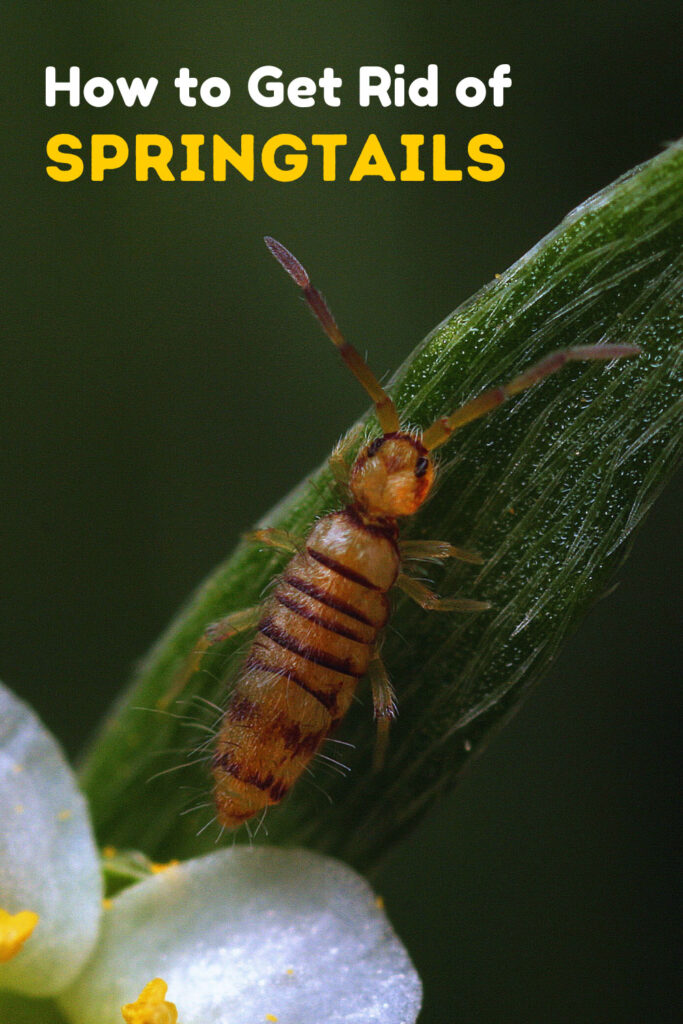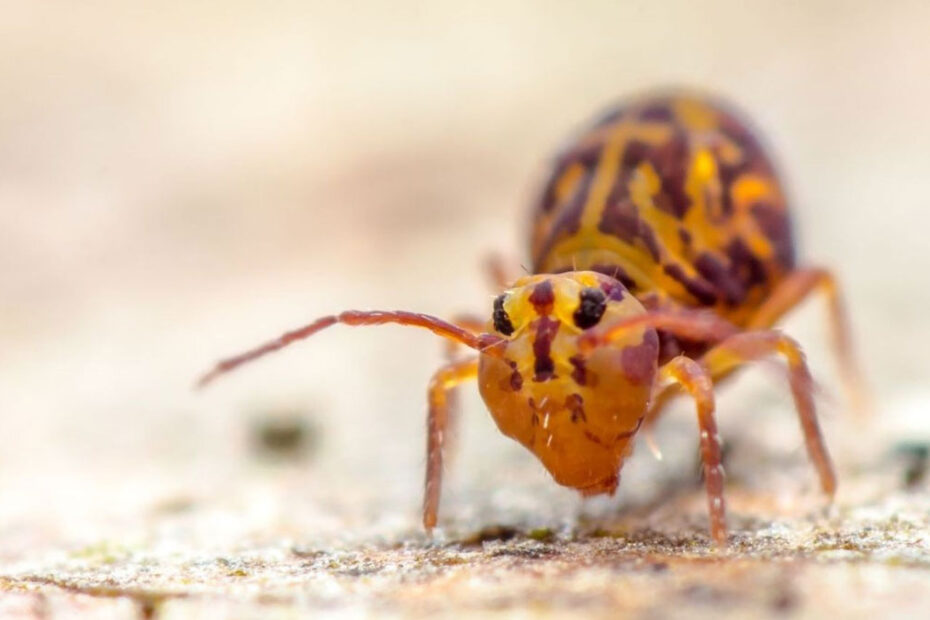Springtails might be tiny, but their presence can be a big nuisance in your home. These minuscule pests thrive in moist environments, often making appearances in bathrooms, kitchens, or any area with excessive humidity. While they’re not harmful to humans or pets, their sheer numbers can make them quite a headache.
You don’t have to let these pests take over your space. With a few strategic steps, you can effectively get rid of springtails and reclaim your home. Whether you’re dealing with a minor infestation or a more significant problem, understanding their habits and knowing how to address them is key. Let’s jump into the most effective methods for eliminating springtails and preventing their return.
Key Takeaways
- Understanding Springtails: Springtails are tiny, moisture-loving insects that thrive in damp and organic-rich environments, making them common in bathrooms, kitchens, basements, and potted plants.
- Identifying Infestations: Look for key signs like visible sightings, sudden movements due to their jumping behavior, and concentration in moist areas to identify a springtail infestation.
- Effective Elimination Methods: Use a combination of chemical treatments, natural remedies such as diatomaceous earth and vinegar sprays, and preventive techniques like fixing leaks and improving ventilation to get rid of springtails.
- Preventive Measures: Control moisture levels, clean regularly, and seal entry points to prevent future springtail infestations. Long-term solutions include improving drainage and using natural repellents like essential oils.
- Regular Maintenance: Maintain a springtail-free home by reducing moisture, cleaning frequently, inspecting for cracks, and avoiding overwatering indoor plants. Sustained efforts ensure these pests stay away.

Understanding Springtails
Springtails are minute, wingless insects that thrive in damp, organic-rich environments. These hexapods often occupy areas with high moisture, such as soil, leaf litter, and decaying plant matter. Recognizing their behavior and habitats helps in effective management and prevention.
Key Characteristics
Springtails (Collembola):
- Size: Typically 0.04 to 0.2 inches (1-5 mm) long.
- Appearance: Small, soft-bodied, varying in colorâwhite, gray, or metallic.
- Furcula: A forked appendage underneath the abdomen used for jumping.
Habitat Preferences:
- Moisture: High humidity areas like bathrooms, kitchens, soil, and basements.
- Organic Matter: Presence of decaying plant material or compost.
Behavior and Lifecycle
Springtails reproduce rapidly in favorable conditions. They lay eggs in clusters near moisture sources. Nymphs hatch and quickly mature into adults, continuing the cycle. Under optimal conditions, populations explode.
Identification
To properly identify springtails:
- Observe Movement: Sudden, jerky movements indicate springtails, thanks to their furcula.
- Inspect Habitat: Check moist areas and potted plants.
- Use Magnification: Due to small size, a hand lens can help confirm identification.
Action Points
Understanding and identifying springtails set the groundwork for effective pest control. Recognize their preferred environments and behaviors to strategize preventive measures.
Common Areas Springtails Infest
Springtails commonly infest specific areas in homes due to their preference for moisture and organic matter. Understanding these locations aids in effective pest management.
Bathrooms
Bathrooms offer ideal conditions for springtails. High humidity, regular water use around sinks, tubs, and toilets, and the presence of organic debris like soap scum and hair foster their habitation.
Key Spots:
- Under sinks: Leaky pipes and damp areas under sinks attract them.
- Bathtubs and showers: Soap residues and constant moisture provide a perfect environment.
- Toilets and grout lines: Moisture accumulation around these areas offers breeding grounds.
Kitchens
Kitchens, with their food particles and water access, attract springtails. Focus on these trouble spots to curb infestations.
Key Spots:
- Beneath appliances: Moisture and food debris behind stoves, refrigerators, and dishwashers are prime spots.
- Under sinks: Leaky pipes and damp cabinets provide conditions conducive to springtails.
- Pantries: Spilled food and humidity can make these spaces inviting.
Basements
Basements, often dark and damp, are significant hotspots for springtails.
Key Spots:
- Near foundation walls: Small cracks or leaks allow water seepage, creating moist environments.
- Stored items: Cardboard boxes and organic materials stored in basements contribute to infestations.
- Laundry areas: Humidity from washing machines and dryers provides an attractive habitat.
Potted Plants
Springtails thrive in the damp soil of potted plants, particularly with overwatering or poor drainage.
Key Spots:
- Soil surface: Moist soil retains moisture, attracting springtails.
- Plant saucers: Excess water collecting here serves as a springtail breeding ground.
Crawl Spaces
Crawl spaces, with limited ventilation and high humidity, are common areas for springtails.
Key Spots:
- Insulation: Moisture-absorbing insulation materials can harbor springtails.
- Vents and openings: Inadequate ventilation increases humidity, making crawl spaces attractive.
- Regular Inspection: Frequently check these areas for moisture and take proactive steps to dry out damp spots.
- Proper Ventilation: Ensure good airflow in bathrooms, kitchens, and basements.
- Repair Leaks: Fix any leaks immediately to reduce moisture levels.
- Reduce Watering: Manage plant watering and improve pot drainage.
Preventing springtail infestations involves addressing these common areas and taking steps to reduce moisture and organic matter.
Identifying a Springtail Infestation
Understanding the signs of a springtail infestation is crucial for effective pest control. Recognizing these signs early helps you manage and eliminate these pests before they become a significant issue.
Signs of Infestation
Identifying a springtail infestation involves observing specific signs that indicate their presence.
Key Indicators:
- Visible Sightings: Spotting tiny, jumping insects around windowsills, sinks, bathtubs, and other moist areas.
- Concentration in Moist Areas: Noticing clusters of small insects near water sources, damp soil, or decaying organic matter.
- Sporadic Movements: Observing sudden, sporadic movements when these insects are disturbed. This is due to their furcula, which propels them into the air.
- Tiny Droppings: Finding tiny, dark-colored droppings around infested areas.
Monitoring these indicators regularly ensures that you detect any infestations early.
Differentiating from Other Pests
It’s important to differentiate springtails from other common household pests to apply the correct control measures.
Comparison with Common Pests:
-
Fleas:
- Appearance: Fleas are slightly larger (up to 0.12 inches) and have darker, harder bodies.
- Behavior: Fleas infest pets and bite humans, while springtails do not bite.
-
Mites:
- Appearance: Mites are smaller, often less than 0.01 inches, and may have a more rounded body shape.
- Habitat: Mites are slow movers compared to the jumping behavior of springtails and often found in dry areas.
- Appearance: Ants are typically larger and have a segmented body with a distinct head, thorax, and abdomen.
- Movement: Ants follow linear trails, whereas springtails move in a more scattered, hopping pattern.
Differentiating these pests ensures you adopt the right strategies for each type. Regular inspection and proper identification are vital for targeted pest control.
Effective Methods to Get Rid of Springtails
Springtails can be a persistent nuisance if left unchecked. To effectively eliminate them, consider using a combination of chemical treatments, natural remedies, and preventive techniques.
Chemical Treatments
Chemical treatments can quickly reduce springtail populations.
- Insecticides: Use insecticides containing bifenthrin, permethrin, or cyfluthrin. Apply around infested areas and potential entry points like cracks and crevices.
- Sprays: Aerosol insect sprays can treat visible springtails. Focus on damp areas such as bathrooms and basements.
- Granules: Apply insecticidal granules around the perimeter of your home to target springtails in the soil.
Natural and DIY Remedies
Natural and DIY remedies offer effective and eco-friendly alternatives.
- Diatomaceous Earth: Sprinkle diatomaceous earth in affected areas. This natural powder dehydrates and kills springtails.
- Vinegar Spray: Mix a solution of equal parts vinegar and water. Spray directly on springtails and infested surfaces.
- Essential Oils: Use essential oils like lavender, peppermint, or tea tree oil. Mix with water and spray in problematic areas to repel springtails.
Prevention Techniques
Prevention is crucial to keep springtails from returning.
- Moisture Control: Fix leaks, use dehumidifiers, and ensure proper ventilation in high-humidity areas.
- Regular Cleaning: Clean your home thoroughly, focusing on areas with organic matter. Remove clutter and debris.
- Seal Entry Points: Inspect your home’s exterior for cracks and gaps. Seal these entry points with caulk or weatherstripping.
By combining these methods, you can effectively manage and eliminate springtail infestations in your home. Regular maintenance and vigilance are key to preventing their return.
Maintaining a Springtail-Free Home
Keeping your home free from springtails requires proactive and consistent efforts. Implementing regular maintenance routines and long-term strategies can help eliminate these pests and prevent future infestations.
Regular Maintenance Tips
Consistent practices help maintain a springtail-free environment. Here are some actionable tips:
- Reduce Moisture Levels: Ensure that indoor areas remain dry. Fix leaks, improve ventilation, and use dehumidifiers in damp areas.
- Clean Regularly: Vacuum floors, especially carpets and areas around baseboards, where springtails can hide. Wipe down surfaces to remove any organic matter.
- Inspect and Repair: Check regularly for any cracks in walls or foundation. Seal gaps and repair damage to prevent springtails from entering.
Long-Term Solutions
Long-term measures provide sustainable springtail prevention:
- Improve Drainage: Ensure proper drainage around your home. Grade landscaping to direct water away from the foundation and use gutters to manage rainwater.
- Use Insecticides: Apply insecticides containing bifenthrin, permethrin, or cyfluthrin around the perimeter of your home, focusing on entry points.
- Natural Repellents: Consider using diatomaceous earth, vinegar sprays, or essential oils like lavender and peppermint. These natural solutions can deter springtails over the long haul.
- Monitor Indoor Plants: Avoid overwatering potted plants and replace soil regularly to minimize suitable breeding conditions.
By adopting these maintenance tips and solutions, you can effectively manage and prevent springtail infestations, ensuring a pest-free home.
Conclusion
By understanding springtails’ habits and preferences, you can effectively tackle these tiny pests. Implementing a combination of chemical treatments, natural remedies, and preventive measures will help you manage and eliminate infestations. Regular maintenance like reducing moisture levels, cleaning, and sealing entry points is crucial for long-term control.
Stay vigilant with inspections and moisture control to keep your home springtail-free. Consistent efforts in improving drainage, using natural repellents, and monitoring indoor plants will ensure a pest-free environment. With these strategies, you can maintain a comfortable and springtail-free home.
Frequently Asked Questions
What are springtails?
Springtails are tiny, wingless insects that thrive in moist environments. They are small (0.04 to 0.2 inches), soft-bodied, and have a forked appendage called a furcula, which allows them to jump.
Where do springtails commonly infest?
Springtails commonly infest areas with high humidity and moisture, such as bathrooms, kitchens, basements, potted plants, and crawl spaces. Specific trouble spots include under sinks, behind appliances, and near foundation walls.
Are springtails harmful to humans or pets?
No, springtails are not harmful to humans or pets. They do not bite or spread diseases but can be a nuisance due to their large numbers.
How can I identify a springtail infestation?
You can identify a springtail infestation by observing their sudden movements, inspecting moist areas, and using magnification tools to see them clearly. Look for visible sightings and tiny droppings in high-humidity areas.
How do springtails reproduce?
Springtails have a rapid reproduction cycle. They lay eggs near moisture sources, which leads to population explosions under optimal conditions.
What steps can I take to prevent springtail infestations?
To prevent infestations, ensure proper ventilation, repair leaks immediately, manage plant watering to reduce moisture levels, and regularly inspect potential trouble spots for signs of springtails.
What are effective methods to eliminate springtails?
Effective methods include chemical treatments with insecticides like bifenthrin, permethrin, or cyfluthrin, natural remedies like diatomaceous earth and vinegar spray, and preventive techniques focusing on moisture control and sealing entry points.
Are there natural remedies to get rid of springtails?
Yes, natural remedies include using diatomaceous earth, vinegar spray, and essential oils like lavender and peppermint to eliminate springtails.
How can I maintain a springtail-free home?
To maintain a springtail-free home, reduce moisture levels, clean regularly, inspect for cracks, improve drainage around the home, apply insecticides at entry points, use natural repellents, and monitor indoor plants to minimize breeding conditions.
